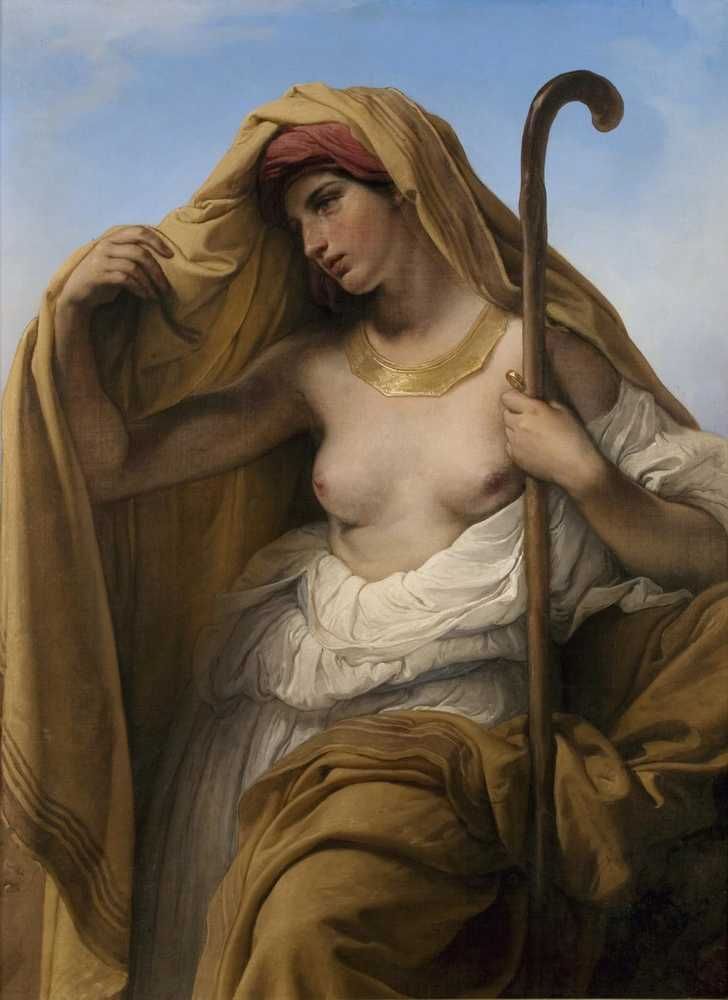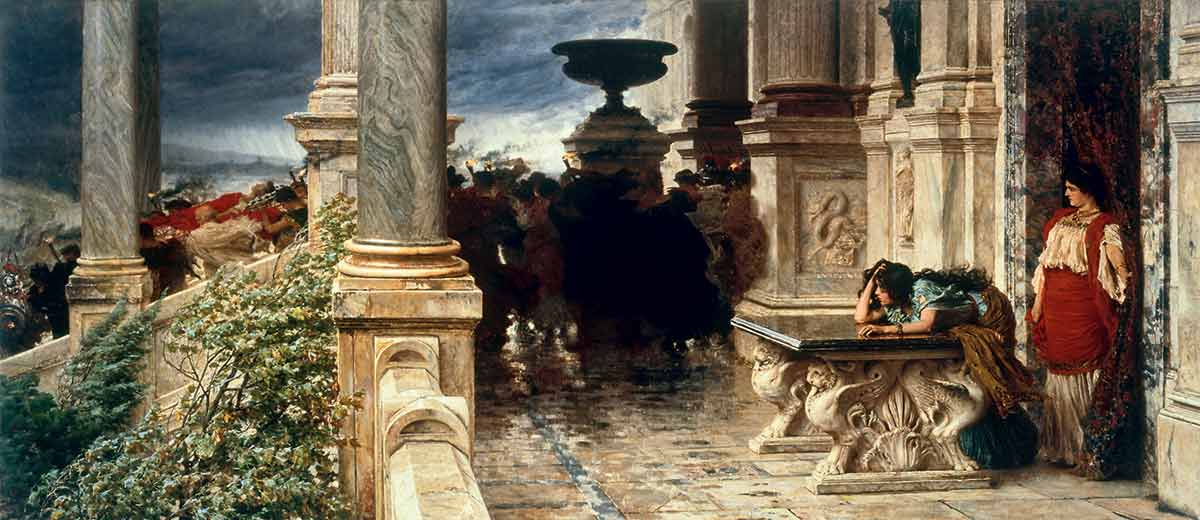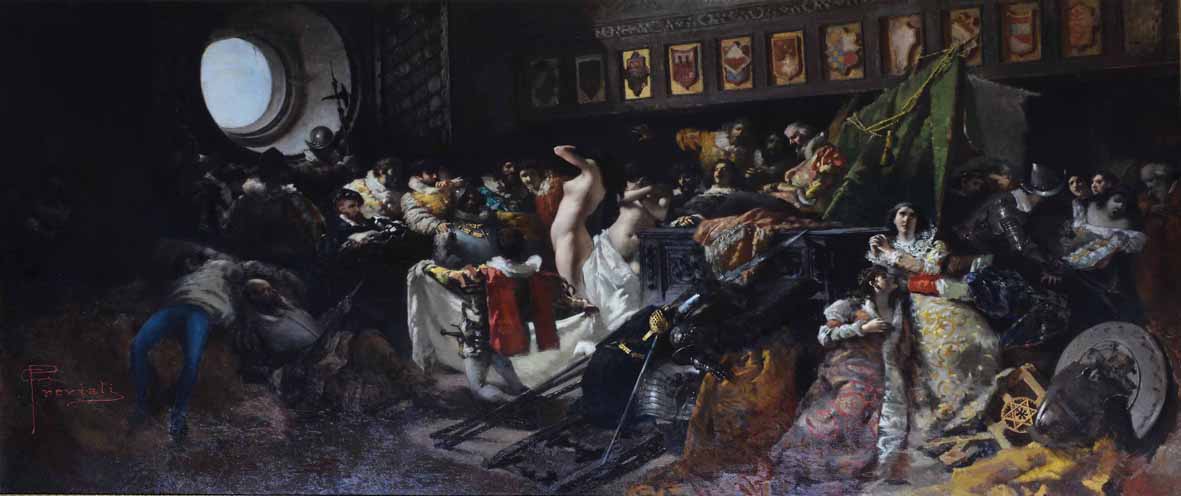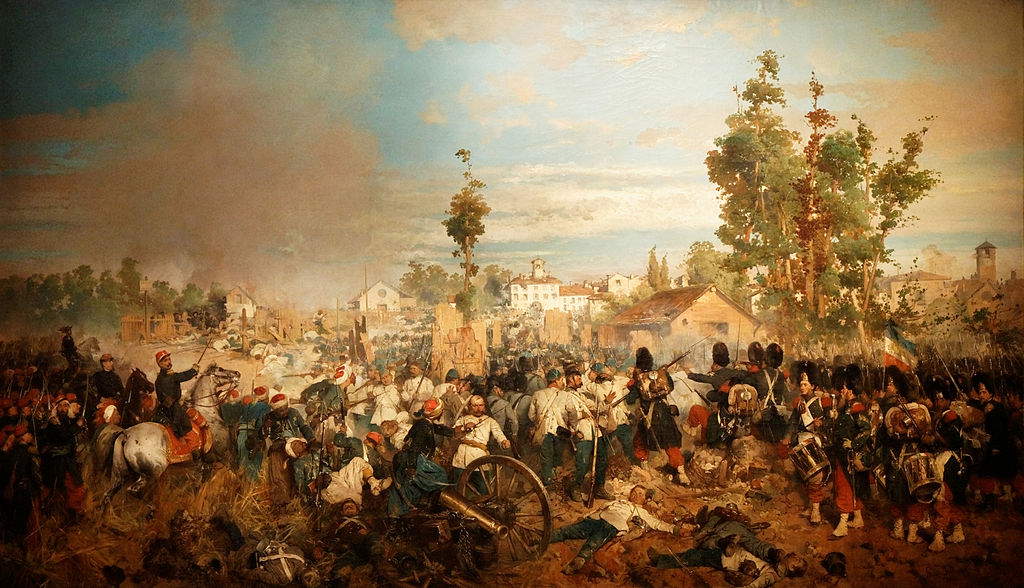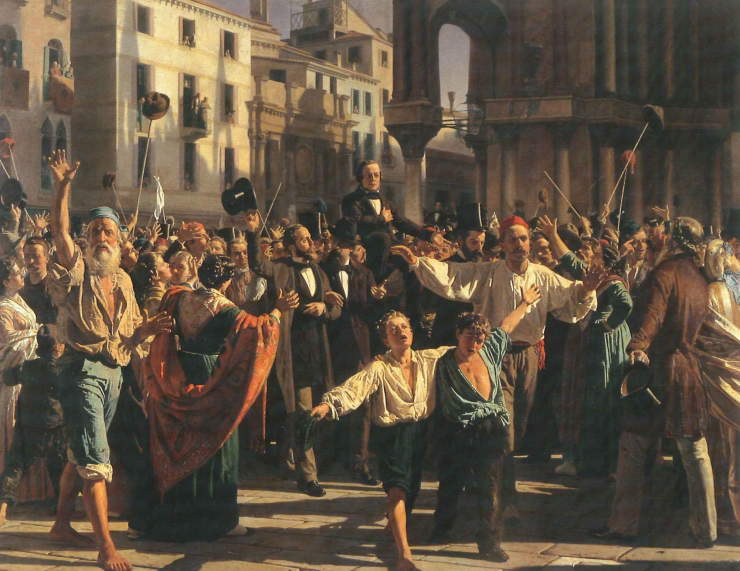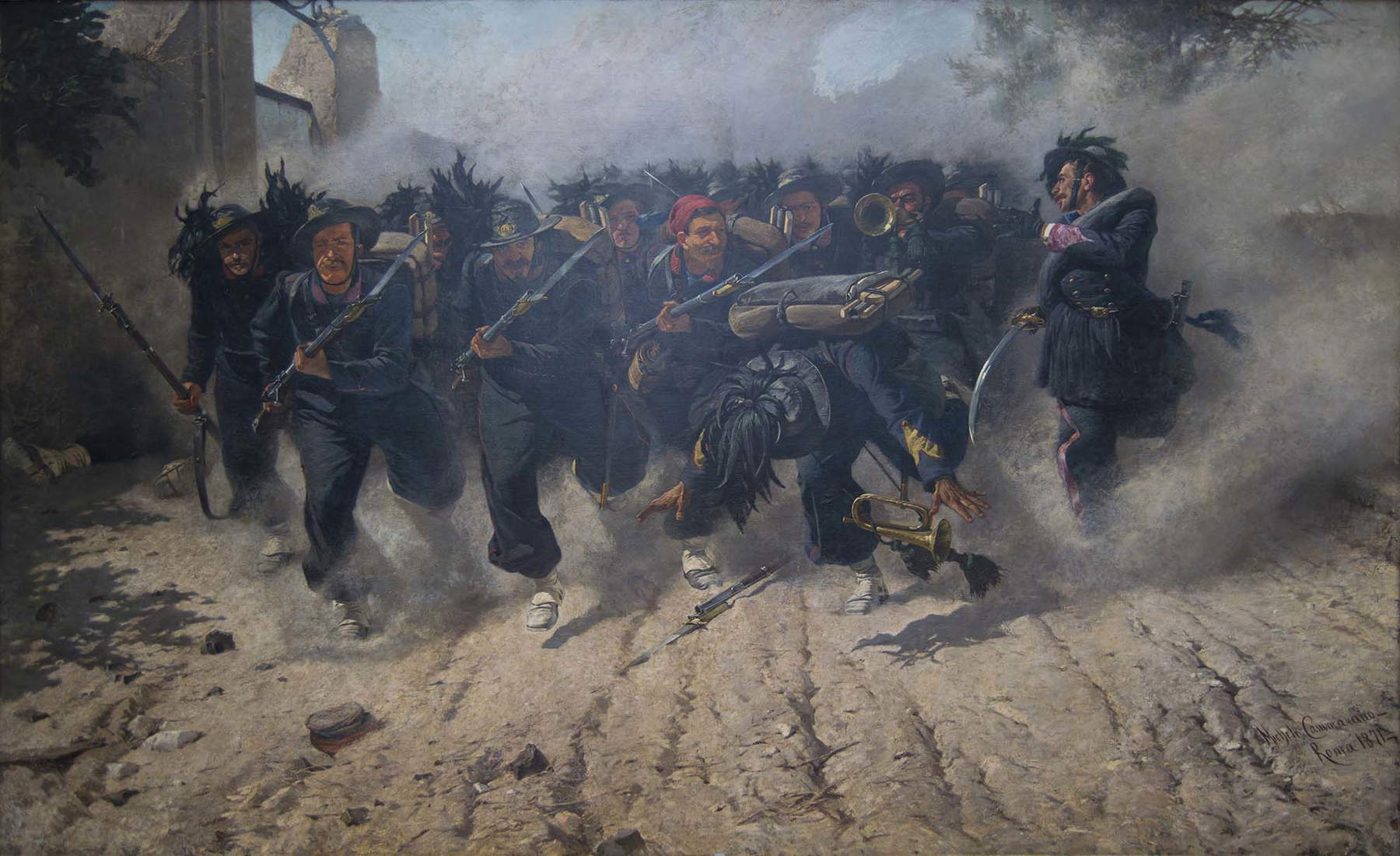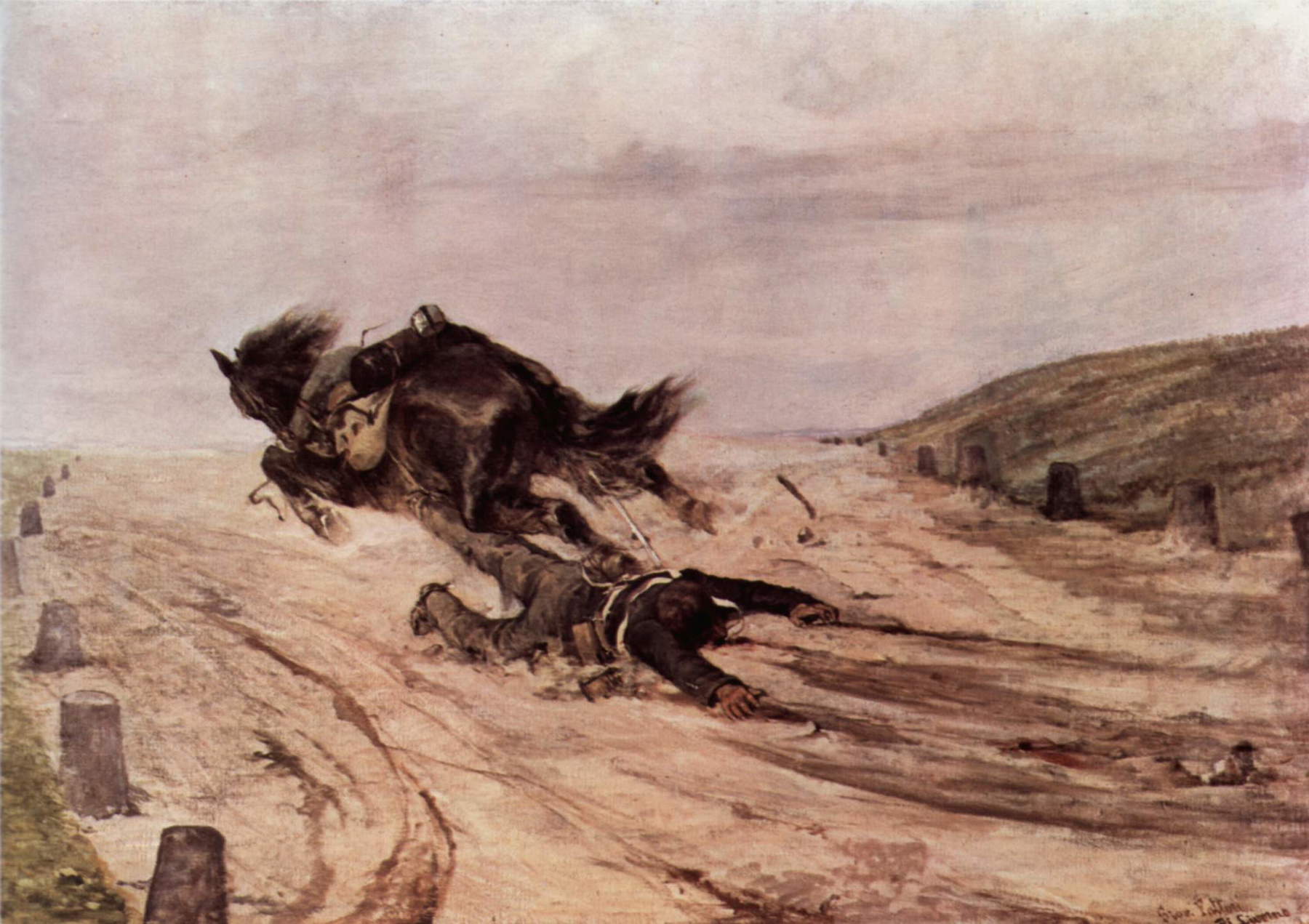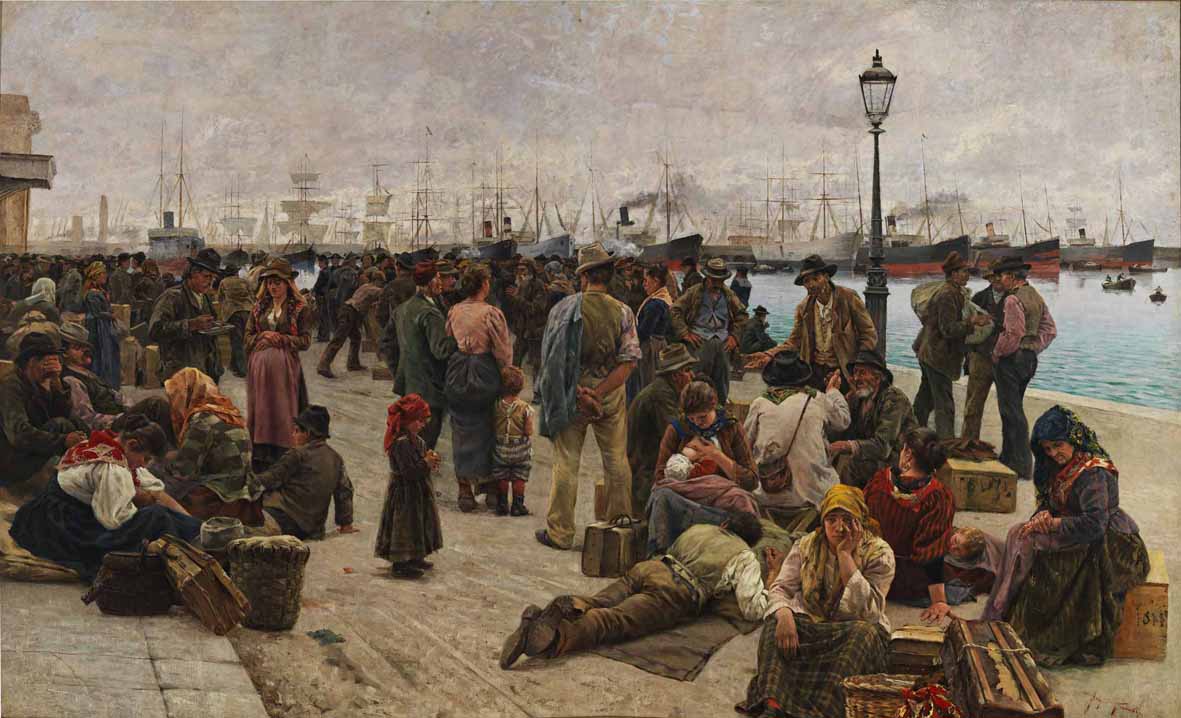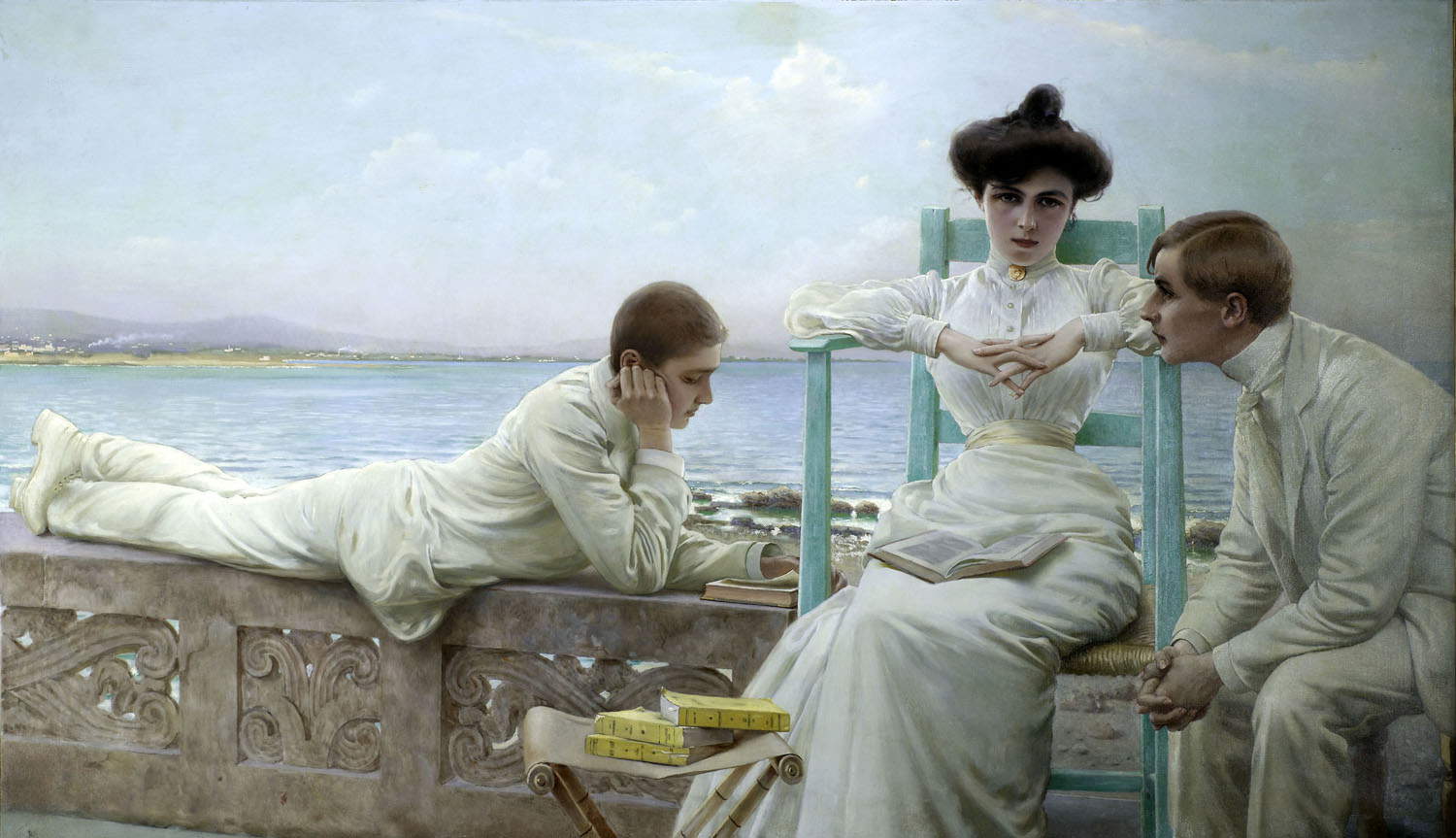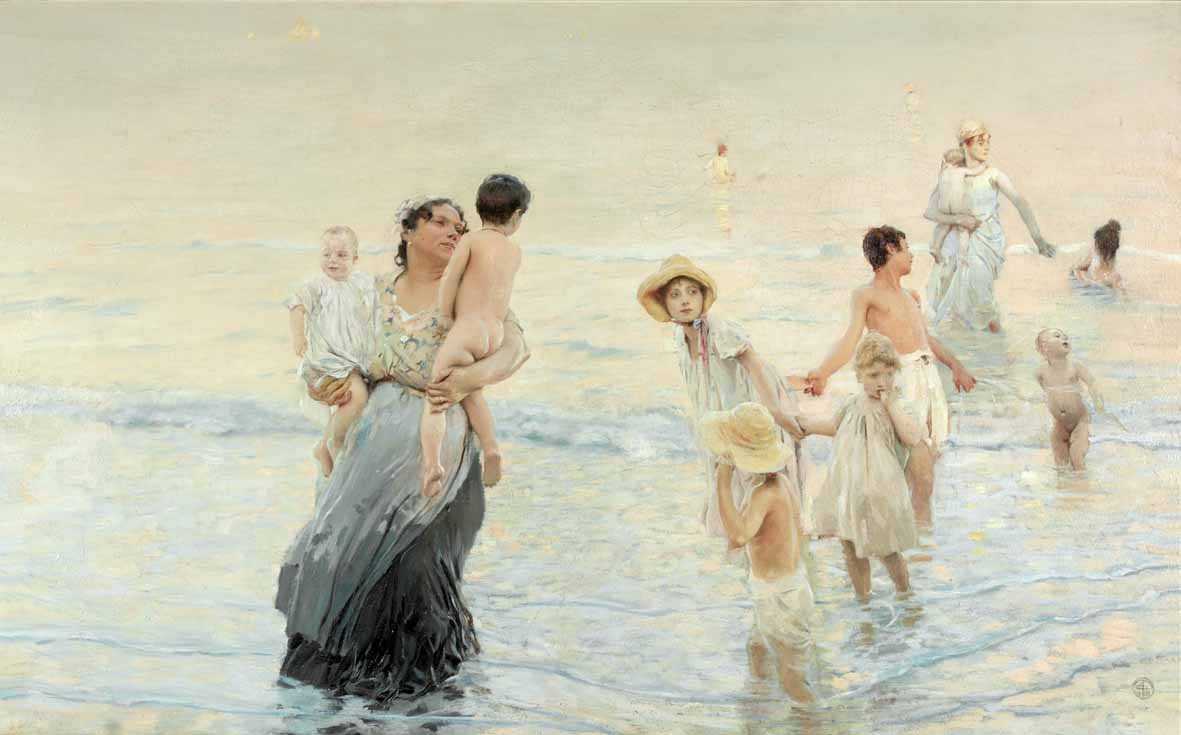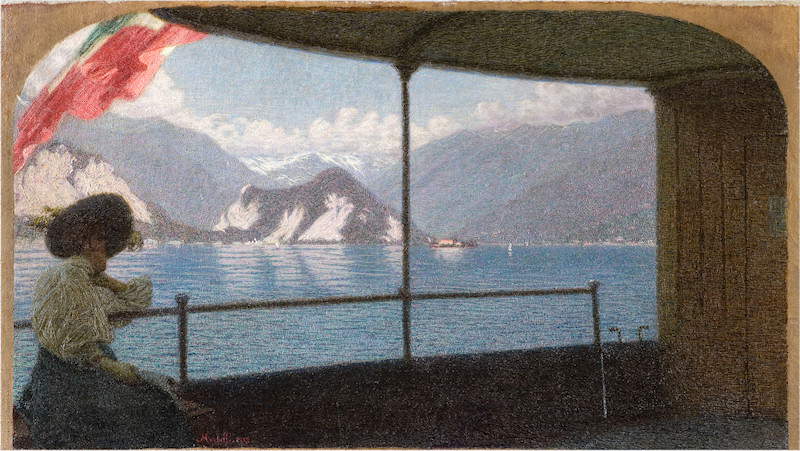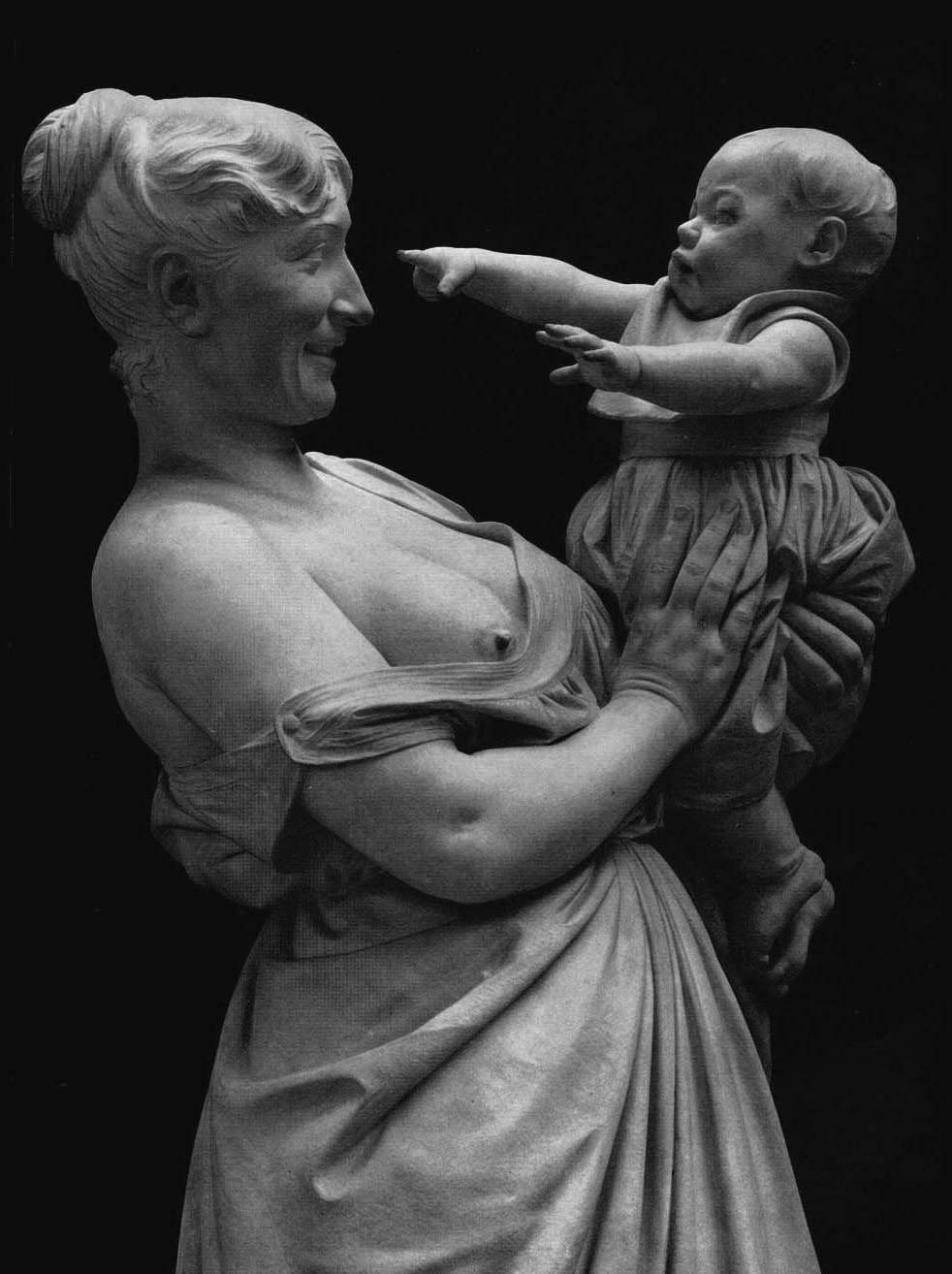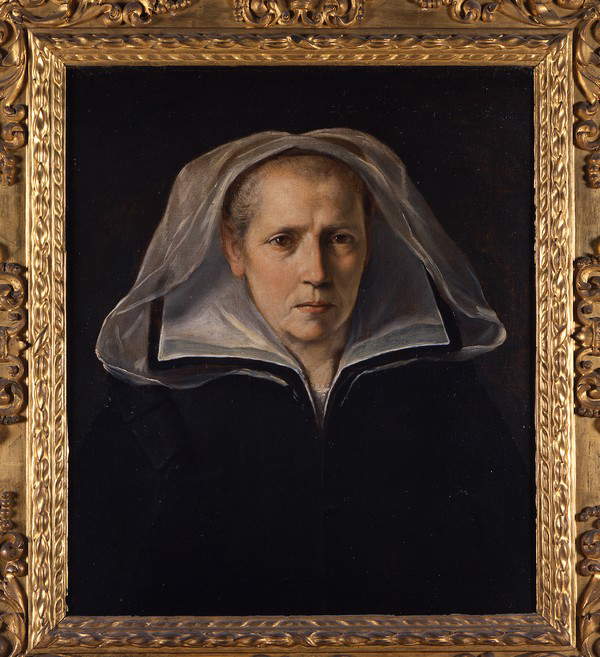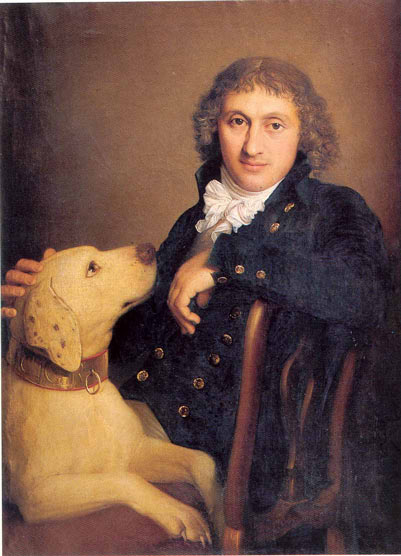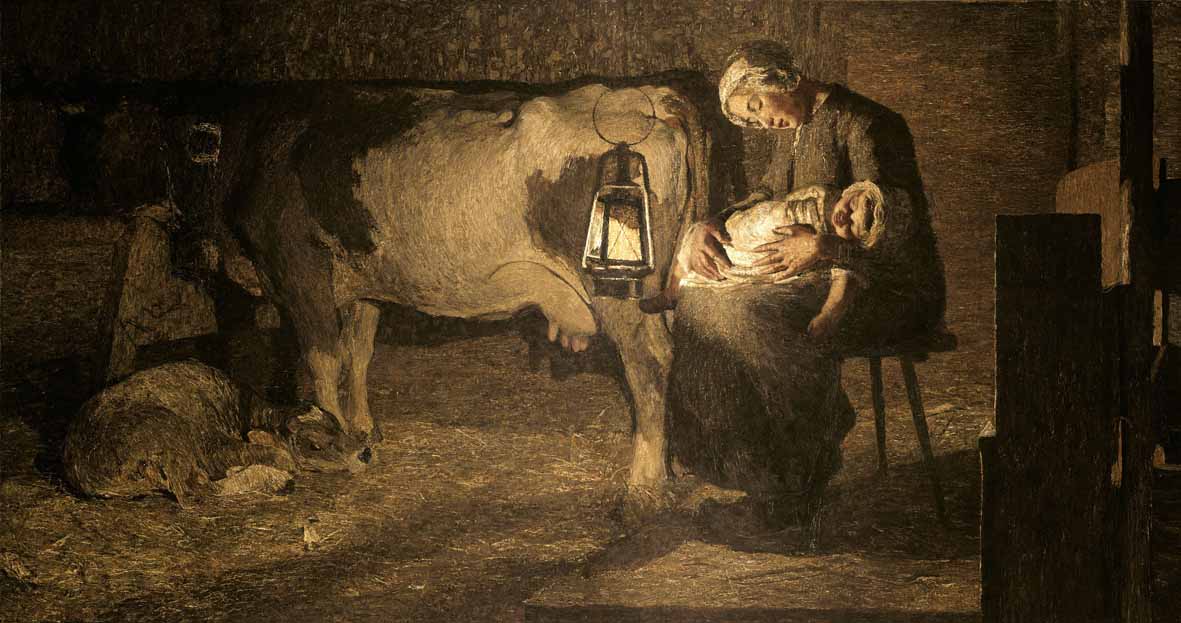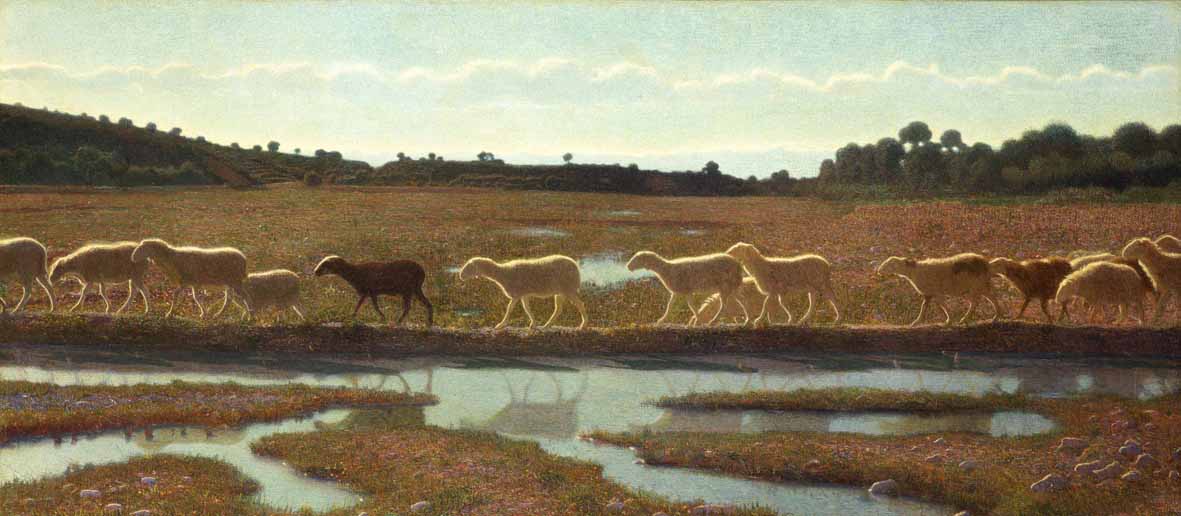by Federico Giannini (Instagram: @federicogiannini1), published on 28/04/2019
Categories:
Exhibition reviews
/ Disclaimer
Review of the exhibition "Ottocento" in Forli, Musei San Domenico, February 9 to June 16, 2019.
In the vast array of exhibitions that many institutions have reserved for the Italian Ottocento in the last period, it seemed impossible not to pay special attention to the Ottocento project, the vast review, curated by Francesco Leone and Fernando Mazzocca, that the Musei di San Domenico in Forlì dedicated to the events of 19th-century art in our country. The intention of setting up an exhibition capable of offering the visitor an all-inclusive account of what happened between the Unification of Italy and the First World War was remarkable and courageous; the parade of masterpieces that for the occasion were gathered and arranged in the ten rooms of the exhibition was extraordinary; and certain curatorial choices were highly refined, such as the closing of the exhibition, a sort of reference to the exhibition of Italian portraiture held in Florence in 1911, on the occasion of the fiftieth anniversary of the Unification of Italy. However, it turns out to be necessary to adduce some premises to better contextualize the path that the public will be confronted with.
One might begin with the fact that Ottocento says nothing that has not already been said. Little there is to elaborate on the introductory section, entrusted in its entirety to the figure of Francesco Hayez (Venice, 1791 - Milan, 1882), presented here as the creator of the new history painting that the review follows to address in the immediately following part: themes already extensively examined in the monograph on Hayez in 2015 and in the excellent one on Romanticism this year (both curated by Mazzocca and both set up at the Gallerie d’Italia in Piazza della Scala in Milan), and also in the bicentennial exhibition of the Galleria dell’Accademia in Venice(Canova, Hayez, Cicognara, held between 2017 and 2018), where the last section was also devoted to the birth of history painting on the merit of the great Venetian painter. As for the side of the history of taste, this is another front that has already been widely explored even recently (an example is the exhibition L’Ottocento elegante that took place in the rooms of Palazzo Roverella in Rovigo in 2011). The comparison between official art and experimental art is not new either, although it must be stressed that on most occasions these were comparisons put in place to bring out the novelty of certain movements with respect to academic art (this is the case, for example, of the very recent exhibition, unfortunately penalized by a disappointing catalog, on the Macchiaioli at the GAM in Turin, where paintings by artists such as Bezzuoli or Pollastrini were used as an opening key to the later experiences of the painters of the Macchiaioli). Also already addressed was the discourse concerning art as a means of constructing a national identity: in part, for example, on the occasion of another exhibition curated by Mazzocca, the one on Giuseppe Mazzini and the great European painting in Genoa, Palazzo Ducale, in 2005, more specifically at the exhibition on the painters of the Risorgimento that took place at the Scuderie in the Quirinale in 2011, for the celebrations of the 150th anniversary of the Unification of Italy, for an event curated again by Mazzocca together with Carlo Sisi, or La nazione dipinta at Palazzo Te in 2007. On the other hand, as far as other themes are concerned, for example the relationship between art, literature and music, the Ottocento passages are so fleeting that it is rather difficult to go into depth.
One of the risks of an exhibition that, instead of approaching the subject with a vertical approach (the most common today), proposes on the contrary an examination conducted according to a horizontal perspective, lies in its excessive exposure to a marginal and shallow treatment of the themes presented in the rooms. This is a risk against which little can also be said to be countered by the very studied layout, designed with the intention of engaging the audience with continuous changes of register, often sudden, between one room and the next, probably also to seek an emotional response: in this sense the exhibition can be said to be well successful, and the impact on the audience is remarkable (it is difficult to find exhibitions so enthralling and exciting, and to realize this it is enough to listen to a few comments from visitors in the rooms). However, the jumps from one environment to another appear so abrupt, and often connected in such an unclear way, that one has to wonder whether, in the end, the overall layout holds up and satisfactorily responds to the high ambitions of the exhibition, or whether, on the contrary, one does not feel a few too many cracks.
 |
| Entrance to the Ottocento exhibition in Forlì |
 |
| One of the rooms of the Ottocento exhibition in Forli. |
The start, as anticipated, is left to Francesco Hayez, a painter straddling two eras, among the greatest interpreters of Romanticism in Italy (if not the greatest tout court) and then an artist who continues to be up-to-date and innovate even late in life: the visitor is greeted by two powerful nudes ( Judah’s Ruth and Tamar, which introduce the sensuality of much nineteenth-century art, which will also be characteristic of certain history painting), and continues his journey by appreciating the Hayez of the great paintings with historical subjects, on which stands out The Destruction of the Temple of Jerusalem, which subtends a bitter reflection by the painter on history itself (the work is dated 1867, and three years later, with Europe still in the midst of wartime upheaval, Hayez would write to Countess Luigia Negroni Prati Morosini that “the old artist [...] feels the sadness of what is happening in the political world.”). Past the room in which Hayez’sEcce Homo is compared with the later Christ Scourged by Pietro Canonica (Moncalieri, 1869 - Rome, 1959), evidently to suggest possible filiations, and past also the last little cell in which it is placed, solitary, the Vase of Flowers brought to Forlì to bring back to the public’s attention that Hayez naturamortist so little considered, we reenter the first corrodoio of the first floor where the curators have prepared the section devoted to historical painting, with a selection that covers almost thirty years of history, from the years around the Unification to the last decade of the 19th century. From the almost direct emanations of Hayez’s art, such as might be the highly calculated Sicilian Vespers by Michele Rapisardi (Catania, 1822 - Florence, 1886), we move on to more up-to-date and spontaneous manifestations such as An Episode in the Life of Fabiola, among the highest expressions of the art of Cesare Maccari (Cesena, 1840 - Rome, 1919) or the neo-Renaissance Cino e Selvaggia by Amos Cassioli (Asciano, 1832 - Florence, 1891), both works made in the same turn of the years as Rapisardi’s Vespers, to compositions that, while not departing from the now traditional and codified historical subjects, approach new solutions: this is the case, for example, of the hitherto little-studied Funerali di Britannico by Giovanni Muzzioli (Modena, 1854 - 1894), in tension between academic legacies and openings to naturalism. Where the exhibition route does not reach, the catalog makes up for it: surprising, for example, is the total absence of Domenico Morelli (Naples, 1823 - 1901) from the exhibition rooms, he who was also one of the first painters, if not the first, to depart from a history painting still totally in the groove of Romanticism to devote himself to research that aimed at resolving subjects within a perspective of more marked naturalness (and in the catalog he is well recognized for this role, just as he is just as effectively placed at the origins of the experiments of other important painters such as Tranquillo Cremona and Federico Faruffini). One encounters an appendix to this second section, after passing the third dedicated to portraits of the protagonists of the culture and politics of the time (ranging from Hayez’s Cavour to Corcos’ Garibaldi, from De Servi’s Puccini to Troubetzkoy’s D’Annunzio), walking down the grand staircase leading to the upper floor: The monumental Cesare Borgia in Capua (Il Valentino) stands out in particular, a significant proof on a historical subject by Gaetano Previati (Ferrara, 1852 - Lavagna, 1890), made, moreover, at a young age (the artist was twenty-seven at the time).
The fourth section is entirely devoted to paintings of military subjects, and is intended to illustrate a sort of “live painting,” as the curators define it, which was frequented as much by painters still linked to the Academy as by those who were devoted to the most daring experiments. The Lombard Gerolamo Induno (Milan, 1825 - 1890), who was present with several works, including his Battaglia di Magenta, presented at the first National Exhibition in Florence in 1861, is known to have been at the origin of this trend, which often prompted artists to go to the battlefields in person to be present at the events they intended to witness. Induno, Mazzocca writes, is a painter from whom “the interpretation and celebration, destined to dominate in the painting of unified Italy, of the Risorgimento as a people’s war where what had counted most was the personal sacrifice and the contribution of humanity made by the humble first in the Crimea and then in the wars of liberation,” took off: the testimony of what happened would involve painters of all experience and from the most diverse areas of the peninsula, with different outcomes. However, it is the works marked by a vivid realism, and above all free from celebratory intentions, that have probably moved the curators’ choices with more conviction, who in this room offer the public a small anthology of the highest and most innovative results of Risorgimento painting. They range from the canvas by Napoleone Nani (Venice, 1839 - Verona, 1899) about the liberation from prison of Venetian patriots Daniele Manin and Niccolò Tommaseo, a work that with a realistic flair recounts an event from about thirty years before the time of its making, to the almost chronachistic Breach of Porta Pia by Michele Cammarano (Naples, 1835 - 1920), an artist who is slowly re-emerging from the inattention to which he was confined for some time (and the recent re-equipping of the Galleria Nazionale d’Arte Moderna e Contemporanea in Rome, Rome, with his Battaglia di San Marino placed at the center of one of the museum’s most spectacular rooms, is confirmation of this), without forgetting the well-known meditations on soldierly themes by Giovanni Fattori (Livorno, 1825 - Florence, 1908), such as Lo staffato, a dynamic and dramatic painting where “everything contributes to conveying, without anecdotal filters, an image of crude violence, so much so that the work provoked reactions of incomprehension and dissent in contemporaries” (Beatrice Avanzi).
 |
| Francesco Hayez, Ruth (1853; oil on canvas, 137 x 100 cm; Bologna, Collezioni Comunali d’Arte) |
 |
| Francesco Hayez, Tamar of Judah (1847; oil on canvas, 112 x 84.5 cm; Varese, Civico Museo d’Arte Moderna e Contemporanea) |
 |
| Francesco Hayez, The Destruction of the Temple of Jerusalem (1859-1867; oil on canvas, 183.3 x 253.3 cm; Venice, Gallerie dell’Accadema) |
 |
| Francesco Hayez, A Vase of Flowers on the Window of a Harem (1869-1881; oil on canvas, 125 x 94.5 cm; Milan, Pinacoteca di Brera) |
 |
| Michele Rapisardi, The Sicilian Vespers (1864-1865; oil on canvas, 233 x 346 cm; Catania, Museo Civico di Castello Ursino) |
 |
| Cesare Maccari, An Episode in the Life of Fabiola (c. 1870; oil on canvas, 152 x 200 cm; Siena, Chigi Saracini Collection, property Banca Monte dei Paschi di Siena) |
 |
| Giovanni Muzzioli, The Funeral of Britannico (1888; oil on canvas, 146 x 330 cm; Ferrara, Museo dell’Ottocento) |
 |
| Gaetano Previati, Cesare Borgia at Capua (1879-1880; oil on canvas, 295 x 588 cm; Intesa Sanpaolo Collection) |
 |
| Gerolamo Induno, The Battle of Magenta (1861; oil on canvas, 208 x 363 cm; Milan, Museo del Risorgimento |
 |
| Napoleone Nani, Daniele Manin and Niccolò Tommaseo freed from prison and carried in triumph to Piazza San Marco (1876; oil on canvas, 252 x 357 cm; Venice, Fondazione Querini Stampalia) |
 |
| Michele Cammarano, The Breach of Porta Pia (1871; oil on canvas, 290 x 467 cm; Naples, Museo e Real Bosco di Capodimonte) |
 |
| Giovanni Fattori, Lo staffato (1880; oil on canvas, 90 x 130 cm; Florence, Palazzo Pitti, Galleria d’Arte Moderna) |
We then proceed to the fifth section, dedicated to themes of social denunciation, mostly centered on the conditions of workers: another topic that has already been extensively addressed in other exhibitions, most recently the exhibition Colori e forme del lavoro at Palazzo Cucchiari in Carrara (2018). The selection of Ottocento is largely similar to that of the Carrara exhibition, although narrower and conducted on a geographical basis rather than on a thematic basis as was the case at Palazzo Cucchiari. Compared to the latter exhibition occasion, artists such as Fattori, Ferroni, D’Orsi, Nomellini, Bistolfi, and Signorini return (of note, however, is the presence of L’alzaia, one of Signorini’s greatest masterpieces, from a private collection, which was absent from the Carrara show, reason why Ottocento represents an important opportunity to see, or see again, the work live), but space is also given to realities more distant from those in Tuscany or the north, such as the Abruzzese one described by Teofilo Patini (Castel di Sangro, 1840 - Naples, 1906), whose social verism seemed almost to give substance to Verga’s writings, or the Sicilian one dramatically recounted by Onofrio Tomaselli (Bagheria, 1886 - Palermo, 1956) with a masterpiece such as I carusi, which describes the plight of adolescents working in the sulfur mines. Space, too, is given to further strands of social denunciation that are in various ways related to the labor discourse but address other topics: we reason, in particular, onemigration, and we dwell on intense works such as Gli emigranti by Angiolo Tommasi (Livorno, 1858 - Torre del Lago, 1923), who goes to a pier in the port of his native Livorno in order to offer the relative a vivid, raw, distressing testimony of the extent of the migratory phenomena that characterized Italy at the end of the 19th century, when our country was a land of migrants who left for the Americas and northern Europe in search of better living conditions. With a further, sudden shift, we move on to the room devoted to landscape: through a selection pulled almost to the limit (the relationship between paintings and poetics is almost on a one-to-one basis), Ottocento attempts to account for all the revolutions known to landscape painting. Present are the post-romantic realism of Nino Costa, the Rivara school with Giuseppe Camino, macchia painting with Telemaco Signorini (and the meditations on macchia of Ciardi and Cabianca, the latter present with an evocative Sul mare), the landscape-state of mind of Sartorio, the pointillism of Giuseppe Pellizza da Volpedo (Volpedo 1868 - 1907) and Giovanni Segantini (Arco, 1858 - Schafberg, 1899), with the former present, toward the final part of the room, with an extremely important painting such as Tramonto (the bush), from the Ricci Oddi Gallery in Piacenza, a work that gives substance to Pellizza’s proposition to let the careful study of natural phenomena open up a painting capable of transcending the strictly naturalistic dimension “in favor of a lightning-fast juxtaposition capable of unlocking the dimension of the supersensible, no longer the physical quality of color and sound but the set of unconscious associations they evoke” (Stefano Bosi), for a result that almost transforms landscape into a kind of abstraction.
With the seventh section we enter weightily into the realm of art as a means of portraying society, and if in the previous room we were thrust into the depths of despair of starving peasants, striking workers, dirty, fatigued and dulled miners, families divided by the drama of migration, the corridor that follows drops the audience into the midst of the amusements of the beautiful world with works by its greatest singers, starting with the italiens à Paris Zandomeneghi and De Nittis, and continuing with the main vate of bourgeois taste, Vittorio Maria Corcos (Livorno, 1859 - Florence, 1933), who in his In lettura sul mare tries to elevate the tone by cloaking the scene, and in particular the protagonist in the center (in whom his wife Ada has been identified), with vaguely Symbolist accents. One flows further into the history of taste when one reviews other champions of the bourgeoisie such as Michele Tedesco (Moliterno, 1834 - Naples, 1917) and his damsels absorbed in affected sollazzi, or the sculptor Giulio Monteverde (Bistagno, 1837 - Rome, 1917) whose sweetened realism and high register(Edward Jenner tries the inoculation of the smallpox vaccine on his son) was best suited to give form, with marble, to the needs of his wealthy clientele (so much so that Monteverde moreover became a much sought-after maker of funerary monuments). The risk of being assailed by boredom is averted by some considerable high points such as Ettore Tito ’s July (Castellammare di Stabia, 1859 - Venice, 1941), a carefree morning of summer bathing at the Venice Lido captured almost like a photographic snapshot, or Angelo Morbelli ’s Battello sul lago Maggiore (Alessandria, 1853 - Milan, 1919), a panorama that becomes a poem of light, or the comparison between Adriano Cecioni ’s La madre (Florence, 1836 - 1886) and that of Silvestro Lega (Modigliana, 1836 - Florence, 1895): the former resolves the idea of motherhood with a realist tone that drew harsh criticism to the sculptor, while the latter, in which we recognize Silvestro Lega’s sister-in-law Adele Mazzarelli, responds with a refined approach that makes manifest that sentimentalism that connoted much of the Romagnolo artist’s production (who, moreover, shared with this his mother the critical failure with Cecioni). The next corridor, reserved for female portraiture (a genre now beaten by myriad other exhibitions), could also be skipped in its entirety without the exhibition losing any of it.
The most interesting section of the exhibition arrives in the closing stages and is paradoxically the one that has the least to do with the subjects of Ottocento, since it is a summary of theItalian Portrait Exhibition set up in Florence in 1911 for the fiftieth anniversary of the Unification of Italy, which at that time, as Ugo Ojetti, curator of that exhibition, wrote, had "never been attempted either in Italy or outside. It is perhaps improper to speak of a re-evocation, since the selection of paintings that that exhibition proposed was set up with contemporary museographic criteria (and obviously it is only a small part of what Ojetti had gathered in the rooms of Palazzo Vecchio), but the idea of including, in the path of Ottocento, a portion of that exhibition that had been imagined seems praiseworthy, as the author himself had taken care to emphasize, to “reveal the continued glory of the Italian Portrait from the last years of the 1500s until 1861, that is, until the proclamation of the Kingdom and the great Art Exhibition that that same year in Florence proved to the new Nation the existence of a magnificently Italian art,” and was guided by the desire to choose “the most beautiful and most important portraits for history.” An exhibition that, however, beyond its rhetorical charge (“the Florentine exhibition,” Tommaso Casini rightly points out in his excellent essay devoted to the great exhibition, “succeeded in consolidating [...] an intrinsic identity and patriotic vocation,” and Ojetti “intended to demonstrate with an explicitly nationalistic and parochial spirit the greatness of Italian art, in comparison with that of other European countries”), had the not inconsiderable merit of being the first to consider the genre of the portrait in a four-century-long overview (and many of the periods that the exhibition went through had been the subject of little or no in-depth study at the time), and at the same time set out to photograph, Casini again points out, the face of a nation. The presence of that exhibition in Ottocento is therefore one of the happiest choices made by the curators, since it offers visitors a summary of the convictions and aspirations of the time on the theme of the relationship between art and identity (and it was, moreover, a very successful exhibition, since it registered more than 170,000 visitors: numbers that are still the stuff of great events today). Mazzocca and Leone’s selection took into account the highest-quality works that the public could find in the thirty crowded rooms of the four apartments of Palazzo Vecchio in which the portraits were arranged: some outstanding paintings such as Guido Reni’s Portrait of the Mother, Luigi Crespi’s Portrait of Ferdinando Gini or Gaspare Landi’s Portrait of Giacomo Rota stand out, while at the back were added portraits executed by artists who were working at the time the exhibition was being mounted. An important work such as the Three Women by Umberto Boccioni (Reggio Calabria, 1882 - Verona, 1916) thus opens the last section of the exhibition, where the trends that would inaugurate the 20th century are analyzed: the task cannot but be entrusted to Giovanni Segantini and Giuseppe Pellizza da Volpedo, whose masterpieces are present (above all Segantini’s celebrated Two Mothers and Pellizza’s The Mirror of Life ), and who, with their experimentalism, bring Divisionist technique, the “true language from which the twentieth century started again” (Francesco Leone), to its heights. To them, the curators add the figure of Francesco Paolo Michetti (Tocco da Casauria, 1851 - Francavilla al Mare, 1929), regarded as the artist who represented, for central and Apennine Italy, what Segantini was for the North and the Alps.
 |
| Telemaco Signorini, The towpath (1864; oil on canvas, 54 x 173.2 cm; Conception Ltd) |
 |
| Onofrio Tomaselli, I carusi (c. 1905; oil on canvas, 184 x 333.5 cm; Palermo, Galleria d’Arte Moderna “Empedocle Restivo”) |
 |
| Angiolo Tommasi, Gli emigranti (1896; oil on canvas, 262 x 433 cm; Rome, Galleria Nazionale d’Arte Moderna e Contemporanea) |
 |
| Giuseppe Pellizza da Volpedo, Sunset (The Bush) (1902; oil on canvas, 73 x 92 cm; Piacenza, Galleria d’Arte Moderna Ricci Oddi) |
 |
| Vittorio Matteo Corcos, Reading by the Sea (c. 1910; oil on canvas, 130 x 228 cm; Private collection) |
 |
| Ettore Tito, July (1894; oil on canvas, 97 x 155 cm; Trissino, Fondazione Progetto Marzotto) |
 |
| Angelo Morbelli, Battello sul Lago Maggiore (1915; oil on canvas, 58.5 x 103 cm; Milan, Fondazione Cariplo Collection) |
 |
| Adriano Cecioni, The Mother, detail (1884-1886; marble, 180 x 50 x 78 cm; Rome, National Gallery of Modern and Contemporary Art) |
 |
| Silvestro Lega, The Mother (a mother) (1884; oil on canvas, 191 x 124 cm; Forlì, Fondazione Cassa dei Risparmi di Forlì Collection) |
 |
| Guido Reni, Portrait of the Mother (1610-1612; oil on canvas, 65 x 55 cm; Bologna, Pinacoteca Nazionale) |
 |
| Luigi Crespi, Portrait of Ferdinando Gini (1759; oil on canvas, 96.7 x 77.6 cm; Bologna, Collezioni Comunali d’Arte) |
 |
| Gaspare Landi, Portrait of Count Giacomo Rota with his Dog (1798; oil on canvas, 100 x 73 cm; Piacenza, Musei Civici di Palazzo Farnese) |
 |
| Umberto Boccioni, Three Women (1909-1910; oil on canvas, 170 x 124 cm; Milan, Gallerie d’Italia, Piazza Scala) |
 |
| Giovanni Segantini, The Two Mothers (1889; oil on canvas, 162.5 x 301 cm; Milan, Galleria d’Arte Moderna) |
 |
| Giuseppe Pellizza da Volpedo, Lo specchio della vita (E ciò che l’una fa, e le altre fanno) (1895-1898; oil on canvas, 132 x 291 cm; Turin, Galleria Civica d’Arte Moderna) |
The main novelty of the Forlì exhibition lies above all in having placed in a unified and diachronic perspective, and in the light of the most recent achievements of studies, such diverse experiences in order to provide the public with a summary of what the nineteenth century was like in Italy: as reiterated, the sections, taken individually, do not add much to what has already been examined in the past (although several are well done: in particular, the one on social themes), but the undeniable popular value of the exhibition and the ability to offer visitors relevant glimpses of what took place in artistic Italy in the nineteenth century remain firm, all enriched by layouts capable of arousing maximum involvement. And if we want to go further, we can consider (as has already been observed) the exhibition in Forlì as a new chapter in the rediscovery of the Italian nineteenth century, as a further stage in a journey that in the last four or five years has undergone a frenetic and important acceleration (just consider the exhibitions listed at the beginning). It will be worth remembering how, on the Italian Ottocento, two circumstances above all have weighed negatively: its extreme fragmentariness and the scarce tendency to contamination and exchange among the different schools that composed the great fresco of the nineteenth century in Italy, and the heavy judgments of many scholars, responsible for a condemnation that for a long period of time had no appeal. For example, Roberto Longhi’s predilection for the coeval French experiences, from realism toimpressionism, had led him to speak of “our minute nineteenth century with its modest reflections of events of far greater weight that occurred in France and were always diminished by us,” and, in reference especially to the Macchiaioli, of “our own, modest adorable provincials,” intending by this to emphasize the delay that, in his opinion, Italian art suffered in relation to contemporary French experiences. Considerations that, for some years now, today’s critics have been trying to overturn in order to place in new light all the original aspects of our nineteenth century.
All in all, nothing new for scholars (even on the discoveries front: there is just a bronze replica, unpublished, of Enrico Butti’s Miner ), and consequently a review that does not stand out for particularly original choices, but for the public a considerable opportunity for in-depth study, a recapitulatory exhibition perhaps a little laborious, but nonetheless rich, especially in well-known works (although there is no shortage of works from private collections, some exhibited for the first time to the public): after all, visiting it is like reviewing the 19th century in a great art history textbook whose pages have been brought “to life” by the curators.

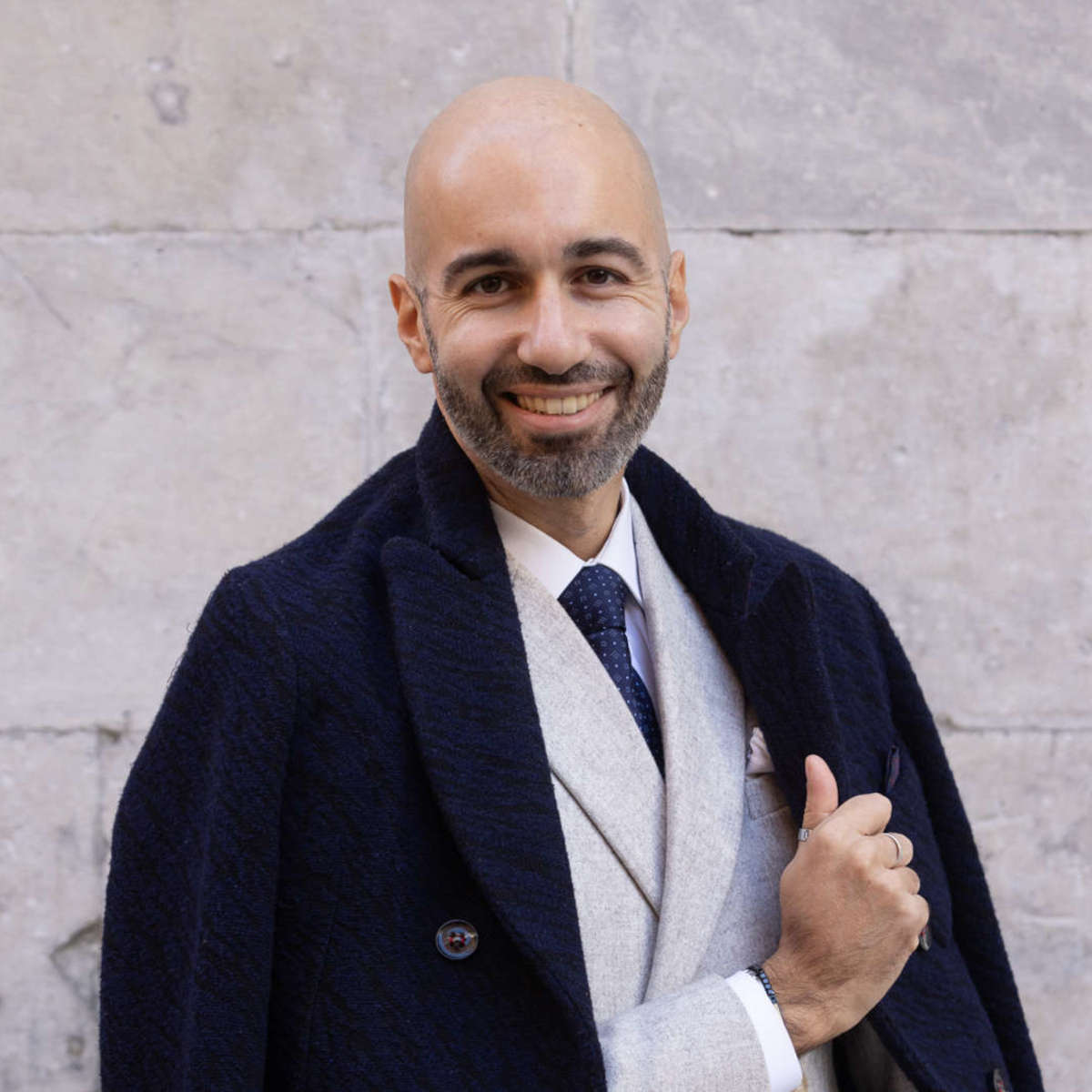
The author of this article: Federico Giannini
Nato a Massa nel 1986, si è laureato nel 2010 in Informatica Umanistica all’Università di Pisa. Nel 2009 ha iniziato a lavorare nel settore della comunicazione su web, con particolare riferimento alla comunicazione per i beni culturali. Nel 2017 ha fondato con Ilaria Baratta la rivista Finestre sull’Arte. Dalla fondazione è direttore responsabile della rivista. Nel 2025 ha scritto il libro Vero, Falso, Fake. Credenze, errori e falsità nel mondo dell'arte (Giunti editore). Collabora e ha collaborato con diverse riviste, tra cui Art e Dossier e Left, e per la televisione è stato autore del documentario Le mani dell’arte (Rai 5) ed è stato tra i presentatori del programma Dorian – L’arte non invecchia (Rai 5). Al suo attivo anche docenze in materia di giornalismo culturale all'Università di Genova e all'Ordine dei Giornalisti, inoltre partecipa regolarmente come relatore e moderatore su temi di arte e cultura a numerosi convegni (tra gli altri: Lu.Bec. Lucca Beni Culturali, Ro.Me Exhibition, Con-Vivere Festival, TTG Travel Experience).
Warning: the translation into English of the original Italian article was created using automatic tools.
We undertake to review all articles, but we do not guarantee the total absence of inaccuracies in the translation due to the program. You can
find the original by clicking on the ITA button. If you find any mistake,please contact us.



